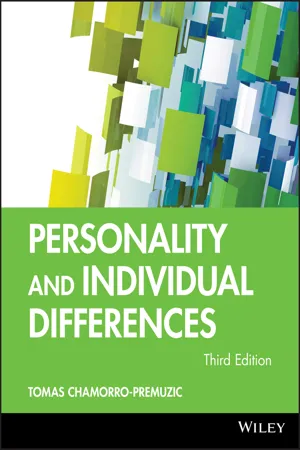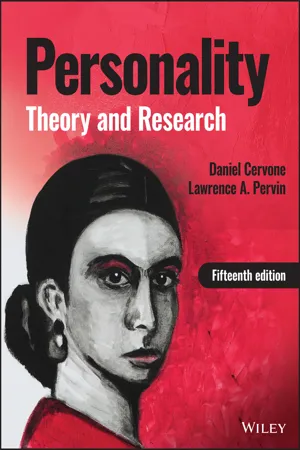Psychology
Trait Theories of Personality
Trait theories of personality propose that individuals possess certain enduring characteristics, or traits, that influence their behavior, thoughts, and emotions. These traits are relatively stable over time and across different situations, and they are used to describe and understand individual differences in personality. Trait theories have been influential in the field of psychology and have contributed to the development of personality assessment tools.
Written by Perlego with AI-assistance
Related key terms
1 of 5
11 Key excerpts on "Trait Theories of Personality"
- eBook - PDF
Personality
Theory and Research
- Daniel Cervone, Lawrence A. Pervin(Authors)
- 2018(Publication Date)
- Wiley(Publisher)
Likewise, personality researchers associated with the trait approach consider traits to be the major units of personality. Obviously, there is more to per- sonality than traits, but traits have loomed large throughout the history of personality psychology. The Trait Concept What, then, is a trait? Personality traits refer to consistent patterns in the way individuals behave, feel, and think. If we describe an individual with the trait term kind, we mean that this individual tends to act kindly over time (weeks, months, maybe years) and across situations (with friends, family, strangers, etc.). In addition, if we use the word kind, we usually mean that the person is at least as kind as the average person. If one believed that the person was less kind than average, he or she would not be described as “kind.” Trait terms, then, have two connotations: consistency and distinctiveness. By consistency, we mean that the trait describes a regularity in the person’s behavior. The person seems predisposed to act in the way described by the trait term; indeed, traits often are referred to as “dispositions” or “dispositional constructs” (e.g., McCrae & Costa, 1999, 2008) to capture the idea that the person appears predisposed to act in a certain way. The idea of disposition highlights an impor- tant fact about trait terms as used by trait theorists of personality. If a trait theorist uses a trait term—for example, sociable—to describe someone, she does not mean that the person always will act sociably, across all settings of life. As the Dutch trait psychologist De Raad (2005) has emphasized, trait terms implicitly refer to behaviors in a type of social context. The trait theorist would expect the sociable person to be consistently sociable across settings that involve other Trait Theory’s View of the Science of Personality 183 people and in which sociable behavior is allowed by prevailing social norms. - eBook - PDF
- Tomas Chamorro-Premuzic(Author)
- 2015(Publication Date)
- BPS Blackwell(Publisher)
What makes you anxious? Research on personality traits deals with the fundamental differences and similarities between individuals. Beginning with a general classification or tax- onomy of the stable and observable patterns of behavior, it goes on to assess the extent to which individuals differ on these variables or traits. Its goal is to predict differences in a wide range of outcomes, from simple reaction time to academic performance, stress, health, salary, and even happiness! Thus personality traits refer to an individual’s description in general and provide a universal frame- work to compare individuals and account for everybody’s individuality at the same time. From the very first known attempts to identify major individual differences and elaborate a taxonomy of personality (usually attributed to the ancient Greek clas- sification of temperaments discussed in Section 2.4) to the current differential and behavior-genetic approaches, personality theorists have attempted to do the same thing; namely, to identify, assess, explain, and predict systematic differences and similarities between individuals, looking for the fundamental and general causes of human behavior. Personality psychologists have aimed to identify the main dimensions by which people differ, test that these dimensions remain relatively stable over time, and explain the etiological basis or causes of these differences between individuals (Cooper, 2002). In that sense, all they have attempted to do is to prove that personality, as defined by the stable and general attributes that explain an individual’s predisposition to act in one way or another, exists (see Table 2.1). However, rather than asking whether personality exists or not, it is important to determine whether the concept of personality traits is useful; that is, whether it will help us predict and understand human behavior and provide any scientific knowledge about the individual. - No longer available |Learn more
Psychology Applied to Modern Life
Adjustment in the 21st Century
- Wayne Weiten, Dana Dunn, Elizabeth Hammer(Authors)
- 2014(Publication Date)
- Cengage Learning EMEA(Publisher)
Cengage Learning reserves the right to remove additional content at any time if subsequent rights restrictions require it. 64 CHAPTER 2 Key Ideas THE NATURE OF PERSONALITY ● The concept of personality explains the consistency in individu- als’ behavior over time and situations while also explaining their distinctiveness. Personality traits are dispositions to behave in certain ways. ● Some theorists suggest that the complexity of personality can be reduced to just five basic traits: extraversion, neuroticism, open- ness to experience, agreeableness, and conscientiousness. The Big Five traits predict important life outcomes, such as grades, occupa- tional attainment, divorce, health, and mortality. PSYCHODYNAMIC PERSPECTIVES ● Freud’s psychoanalytic theory emphasizes the importance of the unconscious. Freud described personality structure in terms of three components (id, ego, and superego), operating at three levels of awareness, that are involved in internal conflicts, which generate anxiety. ● According to Freud, people often ward off anxiety and other unpleasant emotions with defense mechanisms, which work through self-deception. He described five psychosexual stages that children undergo in their personality development. ● Jung’s analytical psychology stresses the importance of the col- lective unconscious. Adler’s individual psychology emphasizes how people strive for superiority to compensate for feelings of inferiority. BEHAVIORAL PERSPECTIVES ● Behavioral theories view personality as a collection of response tendencies shaped through learning. Pavlov’s classical condition- ing can explain how people acquire emotional responses. ● Skinner’s model of operant conditioning shows how conse- quences such as reinforcement, extinction, and punishment shape behavior. Bandura’s social cognitive theory shows how people can be conditioned indirectly through observation. He views self-efficacy as an especially important personality trait. - eBook - PDF
- Jerry Burger, , , , Burger(Authors)
- 2014(Publication Date)
- Cengage Learning EMEA(Publisher)
In addition, many of the characteristics examined by trait researchers, such as self-esteem and social anxiety, are relevant to a client ’ s well-being. But research findings on person-ality traits typically provide only a direction for how to change people who may be too high or too low on a personality dimension. Trait psychologists are more likely to be academic researchers than practicing therapists. Important Trait Theorists You will notice references to traits and trait measures scattered throughout most of the chapters in this book. This is testimony to how widely accepted the trait concept has become in personality psychology. Personality psycholo-gists from nearly every approach, as well as researchers from many other fields of psychology, use traits and trait measures in their work. The expan-sion of the trait approach from virtually nothing less than a century ago to its prominent influence today can be attributed in part to the pioneering work of some early trait theorists. 154 CHAPTER 7 • The Trait Approach Copyright 2015 Cengage Learning. All Rights Reserved. May not be copied, scanned, or duplicated, in whole or in part. Due to electronic rights, some third party content may be suppressed from the eBook and/or eChapter(s). Editorial review has deemed that any suppressed content does not materially affect the overall learning experience. Cengage Learning reserves the right to remove additional content at any time if subsequent rights restrictions require it. Gordon Allport The first recognized work on traits by a psychologist did not appear until 1921. That was the year Gordon Allport, along with his brother Floyd, pub-lished Personality Traits: Their Classification and Measurement. Gordon Allport also taught what is believed to be the first college course on personal-ity in the United States, in 1925 (Nicholson, 1997). - eBook - PDF
Psychology of Personality
Viewpoints, Research, and Applications
- Bernardo J. Carducci(Author)
- 2015(Publication Date)
- Wiley(Publisher)
nomothetic approach The study of common traits by comparing the personality of different people. organizational psychology The study of principles of psychology applied to behavior in work settings. personal dispositions Traits that are unique to the indi- vidual. personalism An approach to psychology emphasizing the study of the person. personalistic An emphasis on the understanding of the individual. psychoticism A basic personality type identified by Eysenck and characterized by varying degrees of personality pathology. Q-data Information about an individual obtained from questionnaires and personality inventories. secondary traits Personal dispositions that influence an individual’s behavior in very specific situations. Sixteen Personality Factor Questionnaire (16PF) A per- sonality inventory used to assess major source traits. source traits Underlying psychological dispositions that influence behavior across a wide variety of situations. specific responses Behaviors observed in particular situ- ations. Study of Values Scale A measure of the six basic human values identified by Allport. surface traits Interrelated forms of behavior serving as observable evidence for the presence of certain under- lying traits. T-data Information about an individual obtained while observing the person in specific situations. temperament traits Manifestations of an individual’s general behavioral style. traits For Eysenck, a set of related behaviors performed across a variety of situations. trait A psychological construct assumed to predispose people to respond in a particular manner. type For Eysenck, the grouping together of related traits. - eBook - PDF
- Spencer Rathus, , , (Authors)
- 2021(Publication Date)
- Cengage Learning EMEA(Publisher)
It was believed that they would restore the balance of bodily “humors.” Early in the 20th century, Gordon Allport and a colleague (Allport & Oddbert, 1936) catalogued some 18,000 human traits from a search through word lists like dictionaries. Some were physical traits such as short, weak, and brunette. Others were behavioral traits such as shy and emotional. Still others were moral traits such as honest. This exhaustive list has served as the basis for personality research by many other psychologists. 10-2b HANS EYSENCK’S TRAIT THEORY British psychologist Hans J. Eysenck (1916–1997) focused much of his research on the relationships between two personality traits: introversion – extraversion and emotional stability–instability (Eysenck & Eysenck, introversion a trait characterized by intense imagination and the tendency to inhibit impulses extraversion a trait characterized by tendencies to be socially outgoing and to express feelings and impulses freely 10-2c THE “BIG FIVE”: THE FIVE-FACTOR MODEL More recent research suggests that there may be five basic personality factors, not two. These include the two found by Eysenck— extraversion and neuroticism —along with conscientiousness , agreeableness , and openness to experience (see Table 10.1). Many personality theorists, especially Robert McCrae and Paul T. Costa Jr. (2013), played a role in the devel-opment of the five-factor model. Cross-cultural research has found that these five factors appear to define the personality structure of American, German, Portuguese, Israeli, Chinese, Korean, Japanese, and Philippine people (Katigbak et al., 2002; McCrae & Costa, 1997). A study of more than 5,000 German, British, Spanish, Czech, and Turkish people sug-gests that the factors are related to people’s basic temperaments, which are considered to be largely inborn (de Moor et al., 2012). - eBook - PDF
Personality
Theory and Research
- Daniel Cervone, Lawrence A. Pervin(Authors)
- 2022(Publication Date)
- Wiley(Publisher)
One therefore needs a separate biological model for each of the three traits. The trait for which Eysenck’s theorizing about underlying biology has proven most successful is extraversion. Eysenck suggested that individual variations in introversion–extraversion reflect individual differences in the neurophysiological functioning of the brain’s cortex. The idea is that introverts are more arousable; they experience more cortical arousal from events in the world. As a result, highly intense social stimuli (e.g., a loud party) make them over aroused—an aversive state that they avoid. The social behavior of introverts, then, is more inhibited because of the relatively greater arousal they experience. Conversely, extraverts experience less cortical arousal than intro- verts from a given stimulus and therefore seek out more intense social experiences. Research that directly measures the brain activity of introverts and extraverts provides some support for Eysenck’s theorizing (Geen, 1997; also see Personality and the Brain feature, this chapter). Eysenck himself generated much relevant evidence on the biology of this dimension, including 208 Trait Theories of Personality: ALLPORT, EYSENCK, AND CATTELL evidence that introverts are more influenced by punishments in learning, whereas extraverts are more influenced by rewards. Since the trait has a biological basis, individual differences in introversion–extraversion should be at least partly hereditary. (Note that the biological basis does not imply that a trait would be entirely hereditary, since one’s experiences during child development influence one’s biologi- cal makeup.) Studies of identical and fraternal twins commonly suggest that heredity does, in fact, play a major part in accounting for differences between individuals in E scores (Krueger & Johnson, 2008; Loehlin, 1992; Plomin & Caspi, 1999). - eBook - PDF
- Richard Ryckman(Author)
- 2020(Publication Date)
- Cengage Learning EMEA(Publisher)
(Adapted from The Biological Basis of Personality, by H. J. Eysenck, 1967, p. 36. Courtesy of Charles C. Thomas, Publisher, Ltd., Springfield, Illinois.) 244 Part 3: Trait Perspectives Copyright 2013 Cengage Learning. All Rights Reserved. May not be copied, scanned, or duplicated, in whole or in part. Due to electronic rights, some third party content may be suppressed from the eBook and/or eChapter(s). Editorial review has deemed that any suppressed content does not materially affect the overall learning experience. Cengage Learning reserves the right to remove additional content at any time if subsequent rights restrictions require it. is based on observed intercorrelations among traits such as sociability, impulsivity, activity, liveliness, and excitability. Each of these traits is inferred from intercorrelated habitual responses such as going to parties, liking to talk to people, going to films on the spur of the moment, and so forth. These habits are themselves inferred from observable specific responses—actual occasions when the person went to a party, talked to people, and so forth. On the basis of numerous factor analyses of personality data gathered from different study participant populations all over the world, Eysenck derived two factors that could readily be labeled introversion/extraversion and stability/neuroticism. Later, on the basis of other statistical analyses, he postulated a third dimension, impulse control/psychoti- cism (Eysenck, 1982, p. 9). These three dimensions, according to Eysenck, are the major individual difference types most useful in describing personality functioning. Once he had identified the three primary dimensions, Eysenck proceeded to construct a paper-and-pencil test to measure them. The original test is the Eysenck Personality Questionnaire (EPQ) (Eysenck & Eysenck, 1975). - eBook - PDF
- Catherine A. Sanderson, Karen R. Huffman(Authors)
- 2019(Publication Date)
- Wiley(Publisher)
not including a large number of central traits c. failing to identify which traits last and which are transient d. not considering situational determinants of personality e. all but one of these options 5. Which of the following is NOT associated with the trait theo- ries of personality? a. Cattell c. Rorschach b. Allport d. Eysenck Q Test Your Critical Thinking 1. After reading the descriptions for each of the Big Five person- ality dimensions, how well do you think they describe some- one you know very well? Can you predict how he or she might score on each of these traits? 2. Do you believe someone can change his or her core personal- ity traits? Why or why not? Real World Application Question [AQ4] Do introverts really not like people and always want to be alone? Hint: Look in the text for [AQ4] Iakov Filimonov/123RF Humanistic Theories 411 Humanistic theories of personality emphasize each person’s internal feelings, thoughts, and sense of basic worth. In contrast to Freud’s generally negative view of human nature, humanists believe that people are naturally good (or, at worst, neutral) and that they possess a natural ten- dency toward self-actualization, an inborn drive to develop all their talents and capabilities. According to this view, our personality and behavior depend on how we perceive and inter- pret the world, not on traits, unconscious impulses, or rewards and punishments. Humanistic psychology was developed largely by Carl Rogers and Abraham Maslow. Rogers’s Theory To psychologist Carl Rogers (1902–1987), the most important component of personality is our self-concept, the way we see and feel about ourselves. Rogers emphasized that mental health and adjustment reflect the degree of overlap (congruence) between our perceived real and ideal selves (see the following Test Yourself). This self-perception is relatively stable over time and develops from our life experiences, particularly the feedback and perception of others. - eBook - PDF
- Karen R. Huffman, Alastair Younger, Claire Vanston(Authors)
- 2013(Publication Date)
- Wiley(Publisher)
Finally, as we saw in Chapter 1, the very presence of an observer can alter the behaviour being studied, whether in the psychologist’s office or in a natural setting. Objective tests Objective personality tests provide specific, objective information about a broad range of per- sonality traits in a relatively short period. However, they are also the subject of several major criticisms: 348 CHAPTER 12 Personality responses given for each image (CBC News, 2009b; Kyle, 2009). Critics claimed that publicizing the test and responses likely invalidates it for future use, by influenc- ing how people will respond to the images. What do you think? Could revealing the content and common answers make the test less valid as a measure of personality? As you can see, each of the four methods of personality assessment has its limits. Psychologists typically combine the results from various methods to create a full picture of an individual’s personality. Is it bad to use defence mechanisms? • Figure 12.6 THE PLANNER ✓ ✓ Summary 1 Trait Theories 326 • Psychologists define personality as an individual’s rela- tively stable and enduring patterns of thoughts, feelings, and actions. • Allport believed that the best way to understand personality was to arrange a person’s unique personality traits into a hierarchy. Cattell and Eysenck later reduced the list of possible personality traits by using factor analysis. • According to the five-factor model (FFM), the five major dimensions of personality are openness, conscientious- ness, extroversion, agreeableness, and neuroticism (OCEAN). 2 Psychoanalytic/Psychodynamic Theories 330 • Freud, the originator of psychodynamic theory, believed that the mind contained three levels of consciousness: the conscious, the preconscious, and the unconscious. He believed that most psychological disorders originate from unconscious memories and instincts. Freud also proposed that personality was composed of the id, the ego, and the superego. - eBook - PDF
- Jerry Burger(Author)
- 2018(Publication Date)
- Cengage Learning EMEA(Publisher)
All Rights Reserved. May not be copied, scanned, or duplicated, in whole or in part. Due to electronic rights, some third party content may be suppressed from the eBook and/or eChapter(s). Editorial review has deemed that any suppressed content does not materially affect the overall learning experience. Cengage Learning reserves the right to remove additional content at any time if subsequent rights restrictions require it. 150 Chapter 7 / The Trait Approach differences in behavior as merely “error variance.” Advocates on the other extreme claim that stable individual differences are the primary determinants of how we act. Early in this debate, some psychologists sought an answer to the person- versus-situation question by measuring how well personality scores and situations predict people’s behavior. Typically, this research found that both the person and the situation were related to behavior and that knowing about personality and the situation was better than having information about only one (Endler & Hunt, 1966, 1968). Unfortunately, this approach has a major weakness. The results of any such investigation are limited by the type of situation and the kind of personality variable examined. For example, we can think of situations in which nearly all people react the same. It would be absurd to try to predict whether high- or low-self-esteem people will run outside when a building catches fire. Although the situation would account for nearly all the variance in this case, it also would be incorrect to conclude that differences in self-esteem are therefore not related to behavior. If we look at other behaviors in other situations, such as how people react to criticism, we will probably find large differences between high- and low-self-esteem individuals. Today, most psychologists agree that the person and the situation interact to determine behavior (Funder, 2009).
Index pages curate the most relevant extracts from our library of academic textbooks. They’ve been created using an in-house natural language model (NLM), each adding context and meaning to key research topics.










